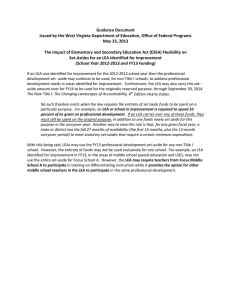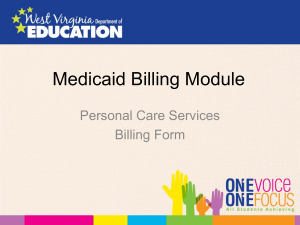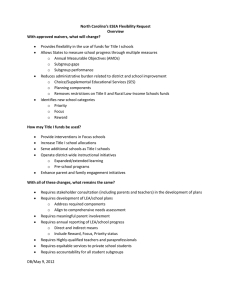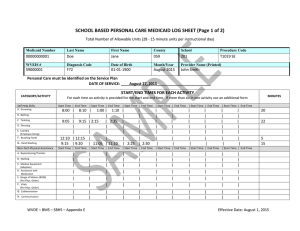ESEA FINANCIAL ISSUES July 8, 2014 WVDE Office of Federal Programs
advertisement
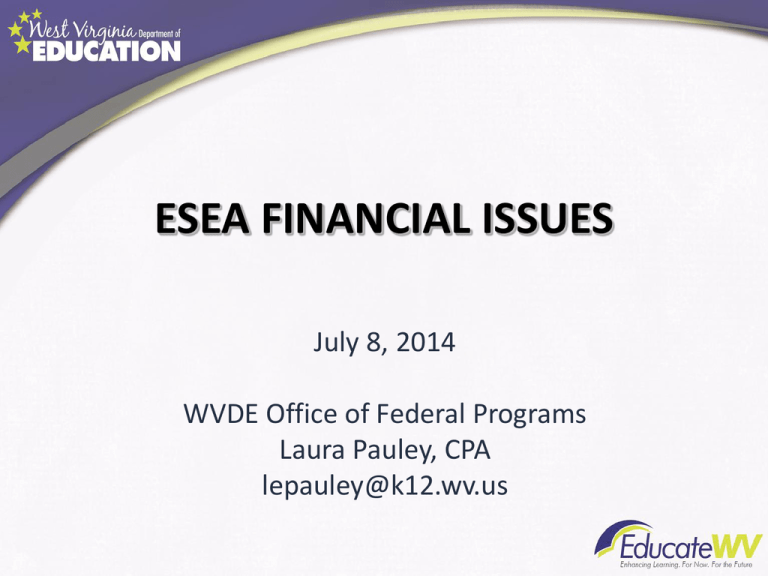
ESEA FINANCIAL ISSUES July 8, 2014 WVDE Office of Federal Programs Laura Pauley, CPA lepauley@k12.wv.us Helpful Links – OMB Circular: December 26, 2013 Federal Register Final Guidance • http://www.gpo.gov/fdsys/pkg/FR-2013-1226/pdf/2013-30465.pdf – Education Department General Administrative Regulations (EDGAR) • http://www2.ed.gov/policy/fund/reg/edgarReg/edgar. html – Elementary and Secondary Education Act (ESEA) • http://www.ed.gov/esea 2 Helpful Links • General Education Provisions Act (GEPA) – http://sn.im/gepa_code • OIG Audit Reports by Office – http://www2.ed.gov/about/offices/list/oig/arepor ts.html • Title I Fiscal Guide – http://www2.ed.gov/programs/titleiparta/fiscalgu id.pdf 3 Helpful Links • Title I Program Monitoring Website – http://www2.ed.gov/admins/lead/account/monit oring/index.html • Title I & III Monitoring Reports – http://www2.ed.gov/admins/lead/account/monit oring/reports13/index.html 4 ESEA Program Updates 5 Updates – New EDGAR finalized December 26, 2014 • To be in line with new Omni Circular • Draft was due out June 26, 2014 – FY 2015 grants issued prior to December 26, 2014 will still be governed by old regulations – New monitoring process being implemented • Omni Circular requires additional monitoring and oversight of LEAs by SEAs • Must do some monitoring of every LEA every year in additional to 5 year schedule 6 Updates • Risk assessments must now be done on all LEAs prior to providing federal funding • Updated 5-17 report (6/6/14) • http://wveis.k12.wv.us/documents/20132014%20ECO%20DISADVANTAGED%20PWVS725I02%20AG E%205-17%20UDPATED%20JUN%2014.pdf • 3 and 4 year-olds inadvertently included in original data pull • 5-17 report for next year will be a certified report (look for this with enrollment reports around Nov/Dec) 7 Carryover • Title II and Title VI Carryover – Increased from 15% limit to 40% (for 9/30/14 only to help offset Title I carryover confusion) • Title I limited to 15% (unless allocation < $50,000) • WV will not be getting another blanket carryover waiver and USDE will be hesitant to provide waivers on a case by case basis 8 Carryover • Still have several counties that needed waivers for 2013 that have not requested them • Only 1 carryover waiver every 3 years • Requirements from ED for granting waivers – SEA must require the LEA to identify the source of the problem and implement procedures to remedy it • SEA also requires waivers for Title II and Title VI (40% limit for 2014 funds) 9 Carryover • US ED is focusing more on higher carryover %’s on programs even if there is no statutory limit – Becoming a monitoring finding – ED’s position is if there are high carryovers then the students are not being served appropriately for the entire grant period – Could lead to future funding cuts 10 Carryover • If an LEA exceeds the carryover limitation and does not receive a waiver, the SEA must reduce the LEA’s current allocation by the amount of overage – Still have several counties that needed waivers for 2013 that have not requested them – Waivers must be received to receive current year funding 11 Handling of Carryover Funds • LEA has several options regarding carryover funds: – Add them to current year allocation and distribute equally among schools (taking into consideration private schools) – Allocate to schools with the highest concentrations of poverty, providing a higher perpupil amount to those schools (taking into consideration private schools) 12 Handling of Carryover Funds – Designate the funds for any of the district wide set-asides • What if the carryover includes unspent funds reserved under a statutory set-aside? – These funds must retain their identity in carryover (e.g. parent involvement) • Not locked into estimated amount listed on grant application which is due July 1st – Doesn’t become carryover until Sept 30th 13 Title I Ranking & Serving • Can elect to serve either in strict rank order or grade span order • Must serve all schools at or above 75% poverty • Can choose to grade span schools below 75% • Have flexibility with the grouping of schools that have overlapping grade spans • Special rules for serving at or below 35% poverty 14 Title I Ranking & Serving • Higher ranking schools cannot have less of a per pupil allocation then lower ranking schools unless: – Grade spanning and less than 75% poverty – Total district enrollment is less than 1,000 – District has only one school in each grade span – Only one county has applied for and currently has a ranking and serving waiver – Priority high school with a graduation rate < 60% 15 Title I Ranking and Serving • Serving a school with less than 35% poverty – If any school with a poverty level less than 35% receives funds then all funded schools must receive at least 125% of the LEA per-poor- pupil amount. – Take entire allocation, divide by total number of low-income students, then multiply by 125% – 125% is calculated prior to any set-asides – Rule forces LEAs to focus their money on higher poverty schools 16 Title I Ranking & Serving • Allocations must be input into WVEIS at the school level and according to approved grant budgets – Treasurers and Superintendents will be copied on approval emails that include the final approved grant budgets to eliminate any miscommunication – Budget transfers can be made between categories with proper approval (>10% in aggregate) – Total amounts elected to be allocated to the schools shouldn’t deviate from approved app 17 Title I Ranking and Serving • Elected set-aside amounts are to be coded to the LEA level in WVEIS – Parent Involvement (not allocated to the schools) – Highly Qualified PD (Stipends/Tuition Reimbursement) – N&D/Homeless – Other Instructional Programs (e.g. Academic Coaches, Sub-Costs, Curriculum Specialists) – Other (e.g. Salary Set-Aside) – Priority/Support/Focus Schools 18 Title I Ranking and Serving • Be mindful when setting up LEA set-asides – Historically, ED has carefully scrutinized districts’ methodology for deriving set-asides to be sure that an LEA did not circumvent the school ranking by reserving funds “off the top” that were then channeled to specific schools outside of the ranked list. 19 Title I Salary Set-Aside • LEAs can elect a Title I Salary Set-Aside to make budgets work (yearly election) – Include base salaries and related benefits at school level and have LEA set-aside for overages – Equalizes staff expenditures at school level – Schools with lower poverty % aren’t penalized for having more expensive veteran teachers – If elected must do salary set-aside for all school level Title I funded staff 20 Title I Salary Set-Aside • WVEIS entry – Can choose to look at the salary and benefits in total as a percentage and split code in WVEIS by location – Will have to revisit with any new-hires – Recordkeeping can get complicated 21 Transferability • Title I allows for certain funds to be transferred into the program – Title II – Title VI • Funds may not be transferred out of Title I • Must include transferred funds in allocation calculation (e.g. set-asides and School allocations) 22 Transferability • Transferability does not affect the period in which the LEA may obligate funds – An LEA cannot extend the period of availability by transferring funds – Funds may not be transferred across fiscal years • May transfer funds more than once during each year 23 Transferability • Must alert SEA of transfer • Submit amended application that includes the transfer 24 Transferability • Items to consider – Once transferred in cannot get back out – Must follow more restrictive Title I program rules – Immediately subject to statutory set-asides – Transfer does not extend obligation period 25 Common Monitoring Findings 26 SEA Monitoring • Inadequate time and effort reporting – Employees not completing semi-annual certification – Time and effort not being done “after-the-fact” – Monthly time and effort not including 100% of employees time – Estimating time and not performing periodic reconciliations • Review quarterly and adjust when difference >10% 27 SEA Monitoring • Federal Program Contracts – Must include the federal grant project code – A description of services – Location of service – Number of days of contracted services – Contract period – Total cost – Be signed by both parties 28 SEA Monitoring • Indirect Costs – OSF requires LEAs to take indirect costs on all grants that allow for them – Indirect costs must be taken on expenditures only in the year in which they occur • Budget Adjustment Approval – Must receive approval for budget adjustments >10% in the aggregate 29 SEA Monitoring • Reimbursing schools for payments made using general school funds – Actual procurement transactions must be handled through the LEA’s central business office • Deviations from purchasing policy 8200 30 SEA Monitoring • Specific Programmatic Requirements: – Only 5% of Title VI allocation may be used for administrative costs – Title III indirect cost rate is capped at 2% – No more than 50% of Title II can be used for salaries for class-size reduction and staff must by HQ at time of hire – HQ Professional Development cannot exceed 5% of total Title I Allocation 31 SEA Monitoring • Specific Programmatic Requirements Cont’d: – Title I amounts budgeted for priority, support, and focus school set-asides cannot exceed 20% of the total Title I Allocation – Title II & Title VI have 15% carryover limitations instituted by the SEA (one-time waiver increases limit to 40% for 2014 funds) 32 OIG Findings • Unallowable Personnel Costs – Employee compensation charged to grants in which the employee did not work on • Unallowable Contract Costs – Contracts were missing required elements; unfulfilled; not properly approved; or included expenditures that exceeded the contract amounts 33 OIG Findings • Inadequately documents personnel costs – Semi annual and monthly time and effort were missing, incomplete, inaccurate, or untimely • Lost or unaccounted for property – Improper inventory control systems • Unallowable supplanting of Federal grant funds 34 OIG Findings • Inadequate policies and procedures • No policies and procedures • Not understanding the regulations and guidance • Policies in place, but not followed 35 US ED • Audit violations deemed “significant” by the US Dept. of Ed Time Distribution Record Retention Problems MOE Late of No Submission of Required Reports Supplement Not Supplant Audits of Sub-recipient Unresolved Unallowable Expenses Lack of Sub-recipient Monitoring Procurement Irregularity Drawdown before funds are needed Ineligible Students Large Carryover Balances Lack of Accountability for Equip Lack of Valid, Reliable or Complete Data Lack of Appropriate Record Keeping 36 Closing Remarks 37
